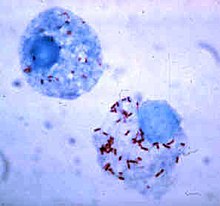
Back ريكتسيا Arabic ريكتسيا ARZ Рыкетсіі (род бактэрый) BE Rikecije BS Rickèttsia Catalan Rickettsia Czech Rickettsier Danish Rickettsien German Rickettsia Spanish Rickettsia ET
Rickettsia is a genus of nonmotile, gram-negative, nonspore-forming, highly pleomorphic bacteria that may occur in the forms of cocci (0.1 μm in diameter), bacilli (1–4 μm long), or threads (up to about 10 μm long). The genus was named after Howard Taylor Ricketts in honor of his pioneering work on tick-borne spotted fever.
Properly, Rickettsia is the name of a single genus, but the informal term "rickettsia", plural "rickettsias," usually not capitalised, commonly applies to any members of the order Rickettsiales. Being obligate intracellular bacteria, rickettsias depend on entry, growth, and replication within the cytoplasm of living eukaryotic host cells (typically endothelial cells).[9] Accordingly, Rickettsia species cannot grow in artificial nutrient culture; they must be grown either in tissue or embryo cultures. Mostly chicken embryos are used, following a method developed by Ernest William Goodpasture and his colleagues at Vanderbilt University in the early 1930s. Many new strains or species of Rickettsia are described each year.[10][11] Some Rickettsia species are pathogens of medical and veterinary interest, but many Rickettsia are non-pathogenic to vertebrates, including humans, and infect only arthropods, often non-hematophagous, such as aphids or whiteflies.[12][13][14] Many Rickettsia species are thus arthropod-specific symbionts, but are often confused with pathogenic Rickettsia (especially in medical literature), showing that the current view in rickettsiology has a strong anthropocentric bias.[15]
Pathogenic Rickettsia species are transmitted by numerous types of arthropods, including chiggers, ticks, fleas, and lice, and are associated with both human and plant diseases.[16] Most notably, Rickettsia species are the pathogens responsible for typhus, rickettsialpox, boutonneuse fever, African tick-bite fever, Rocky Mountain spotted fever, Flinders Island spotted fever, and Queensland tick typhus (Australian tick typhus).[17] The majority of pathogenic Rickettsia bacteria are susceptible to antibiotics of the tetracycline group.
- ^ a b c d e f g h Skerman VB, McGowan V, Sneath PH, eds. (1989). Approved Lists of Bacterial Names (amended ed.). Washington, DC: American Society for Microbiology.
- ^ Truper HG, De' Clari L (1997). "Taxonomic note: Necessary correction of specific epithets formed as substantives (nouns) 'in apposition'". Int J Syst Bacteriol. 47 (3): 908–909. doi:10.1099/00207713-47-3-908.
- ^ Beati, L.; Meskini, M., et al. (1997), "Rickettsia aeschlimannii sp. nov., a new spotted fever group rickettsia associated with Hyalomma marginatum ticks", Int J Syst Bacteriol 47 (2): 548-55s4
- ^ Kelly PJ, Beati L, Mason PR, Matthewman LA, Roux V, Raoult D (April 1996). "Rickettsia africae sp. nov., the etiological agent of African tick bite fever". International Journal of Systematic Bacteriology. 46 (2): 611–614. doi:10.1099/00207713-46-2-611. PMID 8934912.
- ^ Fujita, H.; Fournier, P.-E., et al. (2006), "Rickettsia asiatica sp. nov., isolated in Japan", Int J Syst Evol Microbiol 56 (Pt 10): 2365–2368
- ^ Billings AN, Teltow GJ, Weaver SC, Walker DH (1998). "Molecular characterization of a novel Rickettsia species from Ixodes scapularis in Texas" (PDF). Emerging Infectious Diseases. 4 (2): 305–309. doi:10.3201/eid0402.980221. PMC 2640119. PMID 9621204. Archived from the original (PDF) on 8 August 2017.
- ^ La Scola, B.; Meconi, S., et al. (2002), "Emended description of Rickettsia felis (Bouyer et al. 2001), a temperature-dependent cultured bacterium"[permanent dead link], Int J Syst Evol Microbiol 52 (Pt 6): 2035–2041
- ^ "Rickettsia". NCBI taxonomy. Bethesda, MD: National Center for Biotechnology Information. Retrieved 8 January 2019.
- ^ Walker DH (1996). Baron S, et al. (eds.). Rickettsiae. In: Barron's Medical Microbiology (4th ed.). Univ of Texas Medical Branch. ISBN 978-0-9631172-1-2. (via NCBI Bookshelf).
- ^ Binetruy F, Buysse M, Barosi R, Duron O (February 2020). "Novel Rickettsia genotypes in ticks in French Guiana, South America". Scientific Reports. 10 (1): 2537. Bibcode:2020NatSR..10.2537B. doi:10.1038/s41598-020-59488-0. PMC 7018960. PMID 32054909.
- ^ Buysse M, Duron O (May 2020). "Two novel Rickettsia species of soft ticks in North Africa: 'Candidatus Rickettsia africaseptentrionalis' and 'Candidatus Rickettsia mauretanica'". Ticks and Tick-Borne Diseases. 11 (3): 101376. doi:10.1016/j.ttbdis.2020.101376. PMID 32005627. S2CID 210997920.
- ^ Sakurai M, Koga R, Tsuchida T, Meng XY, Fukatsu T (July 2005). "Rickettsia symbiont in the pea aphid Acyrthosiphon pisum: novel cellular tropism, effect on host fitness, and interaction with the essential symbiont Buchnera". Applied and Environmental Microbiology. 71 (7): 4069–4075. Bibcode:2005ApEnM..71.4069S. doi:10.1128/AEM.71.7.4069-4075.2005. PMC 1168972. PMID 16000822.
- ^ Himler AG, Adachi-Hagimori T, Bergen JE, Kozuch A, Kelly SE, Tabashnik BE, et al. (April 2011). "Rapid spread of a bacterial symbiont in an invasive whitefly is driven by fitness benefits and female bias". Science. 332 (6026): 254–256. Bibcode:2011Sci...332..254H. doi:10.1126/science.1199410. PMID 21474763. S2CID 31371994.
- ^ Giorgini M, Bernardo U, Monti MM, Nappo AG, Gebiola M (April 2010). "Rickettsia symbionts cause parthenogenetic reproduction in the parasitoid wasp Pnigalio soemius (Hymenoptera: Eulophidae)". Applied and Environmental Microbiology. 76 (8): 2589–2599. Bibcode:2010ApEnM..76.2589G. doi:10.1128/AEM.03154-09. PMC 2849191. PMID 20173065.
- ^ Labruna MB, Walker DH (October 2014). "Rickettsia felis and changing paradigms about pathogenic rickettsiae". Emerging Infectious Diseases. 20 (10): 1768–1769. doi:10.3201/eid2010.131797. PMC 4193273. PMID 25271441.
- ^ Perlman SJ, Hunter MS, Zchori-Fein E (September 2006). "The emerging diversity of Rickettsia". Proceedings. Biological Sciences. 273 (1598): 2097–2106. doi:10.1098/rspb.2006.3541. PMC 1635513. PMID 16901827.
- ^ Unsworth NB, Stenos J, Graves SR, Faa AG, Cox GE, Dyer JR, et al. (April 2007). "Flinders Island spotted fever rickettsioses caused by "marmionii" strain of Rickettsia honei, Eastern Australia". Emerging Infectious Diseases. 13 (4): 566–573. doi:10.3201/eid1304.050087. PMC 2725950. PMID 17553271.
